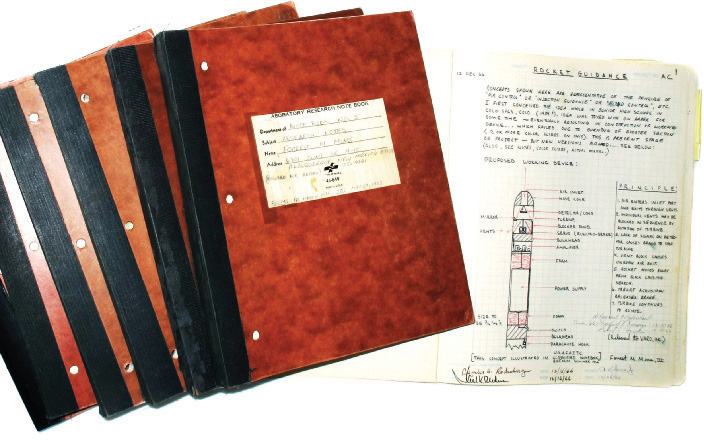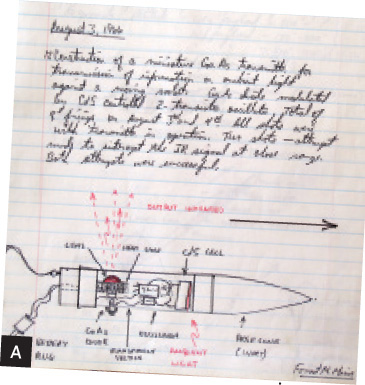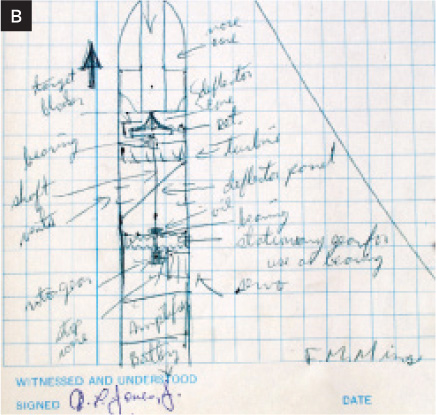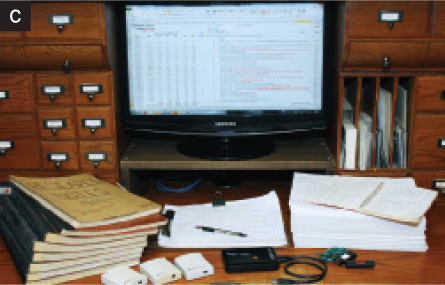PROJECTS COUNTRY SCIENTIST

COUNTRY Scientist
How to Document What You Make or Discover
No matter what you plan to make, invent, or discover, one of the best steps you can take is to keep a detailed record of your progress. The traditional mechanism for documenting inventions and projects is a paper notebook, preferably one that is bound to assure that pages have not been added or removed. While paper notebooks remain very popular and are easy to update and store, the computer era has provided a variety of ways to record the progress of a project in far more detail and flexibility than possible with paper.
If you have commercial plans for what you’re designing or making, a notebook will help establish your intellectual property rights and document your expenses. Be sure to enter all your ideas into your notebook but keep in mind that ideas alone are not patentable. Your notebook should disclose how to transform an idea into a working apparatus, tool, rocket, instrument, robot, or computer program.
Keeping a Traditional Paper Notebook
During high school I kept notes about various projects on standard loose-leaf notebook pages. Most of those pages were lost, including the ones that described an analog computer that could be programmed to translate 20 words of one language into another. When I donated this computer to the Smithsonian Institution in 1986, it was still in good condition, but there were no notes about its design and construction. The lesson is clear: record details about your inventions and projects.
That’s what I began doing while a senior at Texas A&M back in 1966. I recorded details about various experiments and projects in a sturdy, 108-page Aladdin spiral-bound notebook. Topics included miniature guided rockets, travel aids for the blind, lightwave communications, and how to use semiconductor diodes and solar cells to both emit and detect light (Figure A).

Fig. A: This relatively neat entry from Mims’ 1966 college notebook shows a rocket payload section that transmitted a signal to the ground over an invisible infrared beam from an early, high-power LED.
William J. Holt was formerly a vice president for research at Varo, Inc., a manufacturer of infrared night-vision gear in Garland, Texas. When I showed Holt my spiral-bound notebook in 1966, he gave me a real laboratory notebook and some sound advice about how to document experiments and inventions. I still recall the essence of his helpful suggestions:
▪ Avoid using a spiral notebook for recording inventions and original research. Instead, use a bound notebook with gridded pages.
▪ Include plenty of detail about your experiment or project.
▪ Date each entry and sign each page of the notebook.
▪ If you make what might be an invention or discovery, ask at least one other person to sign that he or she has read and understood what you have described (Figure B).
Fig. B: Notebook pages can also be “off-the-cuff” sloppy, like this sample from Mims’ first real lab notebook from 1966. More important than neatness is simply showing how to transform ideas into working projects, like this ram-air control mechanism to guide small rockets.
▪ Don’t worry about neatness. It’s best to simply enter everything you think is important, scribbles and all.
The lab notebook Holt gave me became the first in a series of 100-page, store-bought lab notebooks. From 1966 to 1996, I kept a record of many projects in these traditional lab notebooks. In addition to the projects described in the 1966 spiral notebook, topics included semiconductor lasers, remotely controlled cameras for making aerial photos from kites and balloons, and instruments that measured haze, water vapor, and the ozone layer. Also included were details about using LEDs and laser diodes as dual-purpose emitters and detectors of audio- and pulsemodulated light beams.
A completely unexpected spinoff from those lab notebooks occurred in 1979 when David Gunzel, then RadioShack’s technical editor, came up with a new book idea. Gunzel suggested an idea for a hand-lettered book filled with electronic circuits that would resemble my lab notebooks. Engineer’s Notebook sprang from Gunzel’s idea and became the first of a series of 19 hand-lettered and illustrated books that sold millions of copies.
Keeping a Virtual Notebook
Paper notebooks retain important advantages, particularly when inventions are described on pages dated and signed by the inventor and witnesses. But when projects are best illustrated with photographs and charts, an electronic notebook provides far more flexibility.
Here are some tips for keeping an electronic notebook:
▪ Develop an organized virtual notebook containing separate folders for various projects, ideas, resources, expenses, and so forth.
▪ Save everything related to each project, including photos, videos, charts, data files, illustrations, circuit diagrams, and CAD files.
▪ Include plenty of detail about your experiment or project.
▪ Explore various ways for you and witnesses to digitally sign your entries.
▪ While you can create your own electronic notebook using standard office software, consider an online search to explore commercial or free electronic notebooks.
Going Further
Whether you keep a paper or electronic notebook — or both — be sure to carefully safeguard your notes by backing them up. Carbon paper may be old-fashioned, but it works well for backing up paper notebook pages. You can also photograph or scan paper notebook pages and save them electronically. That’s what I’m doing with all my old notebooks (Figure C).
Fig. C: The entire contents of Mims’ lab notebooks, thousands of pages of his atmospheric data (5 of 24 years shown at right), many thousands of scientific photographs, and much more can be easily saved on just one of the flash drives shown at right or on a small fraction of the portable hard drive at center bottom.
As for electronic backups, I suggest storing your electronic notebooks on at least two external flash or hard drives.
An online search will provide many more tips about keeping a laboratory notebook. Try searching “keeping a laboratory notebook.” Our hardbound, gridded Maker’s Notebook is a perfect paper option: makezine.com/go/notebook. ![]()
Forrest M. Mims III (forrestmims.org), an amateur scientist and Rolex Award winner, was named by Discover magazine as one of the “50 Best Brains in Science.” His books have sold more than 7 million copies.


